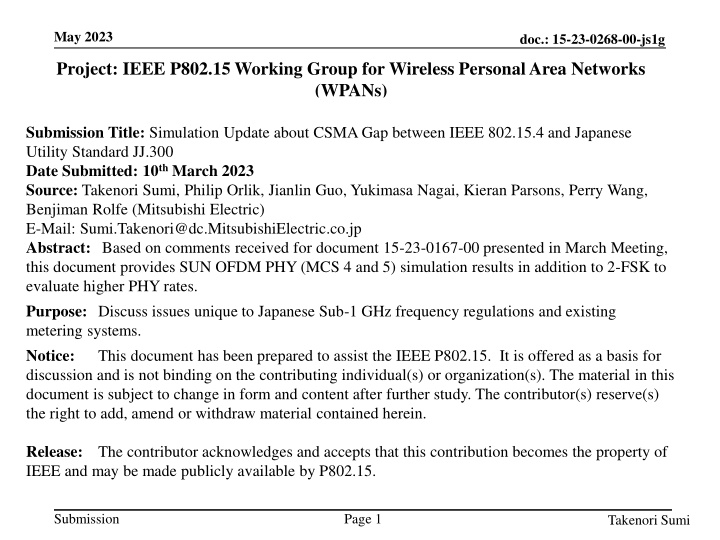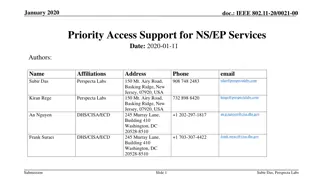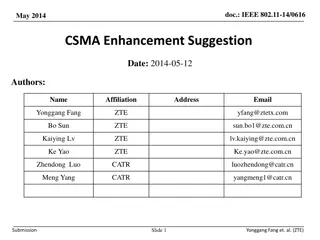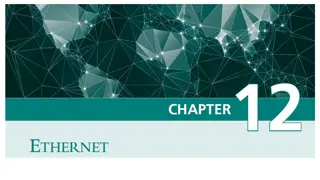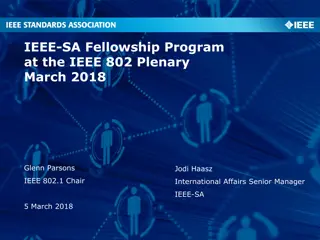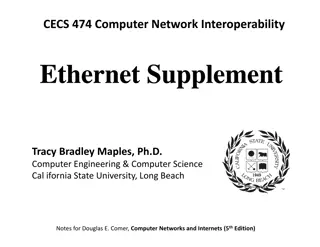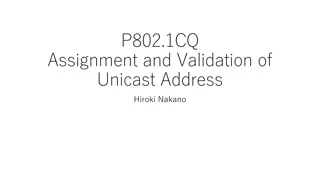Simulation Update: CSMA Gap between IEEE 802.15.4 and Japanese Utility Standard JJ-300
Unique issues in Japanese Sub-1 GHz frequency regulations and existing metering systems, focusing on the compatibility of IEEE 802.15.4 with Japan's metering needs. It presents simulation results comparing SUN OFDM PHY and 2-FSK, highlighting the potential improvements in packet delivery rates using suspendable CSMA/CA under congested scenarios. Japanese utility systems face challenges due to limited spectrum bandwidth, requiring enhanced throughput capabilities and multi-metering functionality. The document emphasizes the importance of addressing congestion and interference issues in the context of evolving utility infrastructure.
Download Presentation

Please find below an Image/Link to download the presentation.
The content on the website is provided AS IS for your information and personal use only. It may not be sold, licensed, or shared on other websites without obtaining consent from the author.If you encounter any issues during the download, it is possible that the publisher has removed the file from their server.
You are allowed to download the files provided on this website for personal or commercial use, subject to the condition that they are used lawfully. All files are the property of their respective owners.
The content on the website is provided AS IS for your information and personal use only. It may not be sold, licensed, or shared on other websites without obtaining consent from the author.
E N D
Presentation Transcript
May 2023 doc.: 15-23-0268-00-js1g Project: IEEE P802.15 Working Group for Wireless Personal Area Networks (WPANs) Submission Title: Simulation Update about CSMA Gap between IEEE 802.15.4 and Japanese Utility Standard JJ.300 Date Submitted: 10th March 2023 Source: Takenori Sumi, Philip Orlik, Jianlin Guo, Yukimasa Nagai, Kieran Parsons, Perry Wang, Benjiman Rolfe (Mitsubishi Electric) E-Mail: Sumi.Takenori@dc.MitsubishiElectric.co.jp Abstract: Based on comments received for document 15-23-0167-00 presented in March Meeting, this document provides SUN OFDM PHY (MCS 4 and 5) simulation results in addition to 2-FSK to evaluate higher PHY rates. Purpose: Discuss issues unique to Japanese Sub-1 GHz frequency regulations and existing metering systems. Notice: This document has been prepared to assist the IEEE P802.15. It is offered as a basis for discussion and is not binding on the contributing individual(s) or organization(s). The material in this document is subject to change in form and content after further study. The contributor(s) reserve(s) the right to add, amend or withdraw material contained herein. Release: The contributor acknowledges and accepts that this contribution becomes the property of IEEE and may be made publicly available by P802.15. Submission Page 1 Takenori Sumi
May 2023 doc.: 15-23-0268-00-js1g Summary This document aims to discuss issues unique to Japanese Sub-1 GHz frequency regulations and existing metering systems and to discuss the concerns about the ability of existing IEEE Std 802.15.4 to support the expected metering application needs in Japan s Sub-1 GHz frequency bands and congested situation. This document provides responses to the comments received for document 15-23-0167- 00 presented in May Meeting. It analysed the CSMA gap between IEEE 802.15.4 and Japanese Standard JJ-300.10 from two aspects: protocol and performance. This document provides SUN OFDM PHY (MCS 4 and 5) simulation results in addition to 2-FSK to evaluate higher PHY rates. The results shows that suspendable CSMA/CA used in JJ-300.10 can improve packet delivery rate up to 9.5% under congested and higher offered load situations. Submission Page 2 Takenori Sumi
May 2023 doc.: 15-23-0268-00-js1g [1] Background of Japanese Utility Systems Japanese utility systems operate in Sub-1 GHz frequency band More specifically in 920 MHz band with limited frequency bandwidth Japanese electric utilities are now updating their 1st generation smart metering infrastructure New requirements are coming to light Meter reporting duty cycles are expected to decrease from 30 minutes to 5 minutes At least a 6x increase in throughput will be needed Likely need for multi-metering functionality on single radio Over-the-air (OTA) firmware/software capability are needed This means more data traffic and more channel access [1] See details at15-23-0167-00 Submission Page 3 Takenori Sumi
May 2023 doc.: 15-23-0268-00-js1g [1] Issues in Japanese Utility Systems Japanese utility systems support ECHONET protocols, which are based on a Japanese Communication Standard JJ-300.10 In Japan, Sub-1 GHz spectrum is scarce At most 2.9 MHz* is optimized for metering applications using CSMA leads to congestion and interference issues as more devices with different protocols exists in narrower bandwidth See IEEE802.19.3 for issues arising from limited spectrum availability and protocol differences among 802.15.4g and 802.11ah For IEEE Std 802.15.4 to better support utility applications in Japan, more enhancements are needed Consider improved support for JJ-300.10 Consider coexistence with more aggressive protocols such as IEEE Std 802.11 In addition, IEEE Std 802.15.4 also needs to take advantage of devices without power constraints, e.g., grid powered smart meters * See pg. 113: 920MHz-BAND TELEMETER, TELECONTROL AND DATA TRANSMISSION RADIO EQUIPMENT ARIB STANDARD [1] See details at15-23-0167-00 Submission Page 4 Takenori Sumi
May 2023 doc.: 15-23-0268-00-js1g [1] CSMA/CA in JJ-300.10 Incorporate Number of Retries (NR) Key differences reside inside of this box Distinguishes unicast and multicast [1] See details at15-23-0167-00 Submission Page 5 Takenori Sumi
May 2023 CSMA Differences Between JJ-300.10 and 802.15.4 doc.: 15-23-0268-00-js1g [1] 802.15.4-2011 JJ-300.10 CSMA/CA differences 1. Consider non-slotted scenario 2. Consider data frame 3. Incorporate number of retries (NR) 4. Distinguish unicast and multicast 5. Outcome of 802.15.4 CSMA is backoff success/failure and outcome of JJ-300.10 CSMA is transmission success/failure 6. Wait for LIFS time before backoff starts 7. Backoff suspension Differences 1-2 make JJ-300.10 a special case of 802.15.4 Differences 3-5 provide more details However, differences 6-7 make JJ- 300.10 channel access different from 802.15.4 [1] See details at15-23-0167-00 Submission Page 6 Takenori Sumi
May 2023 doc.: 15-23-0268-00-js1g [1] JJ-300.10 Backoff Operation Backoff operation specified in Figure 5-17 of JJ-300.10 Wait Backoff suspension of Node 3 Expected impact of LIFS wait Increase latency due to the delayed backoff start Expected impact of backoff suspension Improve packet delivery reliability due to less frame drop caused by backoff failure Increase latency due to longer backoff time Reduce number of backoffs JJ-300.10 performs re-backoff only if busy channel starts in CCA period o 802.15.4 performs re-backoff if channel is busy in CCA period [1] See details at15-23-0167-00 o Submission Page 7 Takenori Sumi
May 2023 doc.: 15-23-0268-00-js1g Simulation Parameters Value Parameter Note Nodes 20, 50, 100 Offered load(Network)[kbps] 10 100 Packet size[Byte] 100 MAC payload PHY parameters Frequency[MHz] 920 Modulation 2-FSK OFDM Option3 MCS4 OFDM Option3 MCS5 100kbps 300kbps 400kbps Channel spacing[kHz] 400 MAC parameters (JJ-300.10 v2.2, Table 5-28, 5-29) LIFS[us] 1000 for JJ-300.10 phyCCADuration[us] 130 aTurnaroundTime[us] 1000 aUnitBackoffPeriod[us] 1130 Rx-to-Tx Turnaround time[us] 300 300 us or more, 1000 us or less Tx-to-Rx Turnaround time[us] 300 Less than 300 us macMaxBE 8 macMinBE 8 macMaxCsmaBackoffs 4 macMaxFrameRetries 3 Submission Page 8 Takenori Sumi
May 2023 doc.: 15-23-0268-00-js1g [1] Node Deployment of 20 Nodes 100 80 60 40 20 y[m] 0 -20 -40 -60 -80 -100 -100-80 -60 -40 -20 0 20 40 60 80 100 x[m] PANC is placed at the center of a 100 m circle. Each node is placed using the sunflower algorithm. Each node sends packets to PANC. [1] See details at15-23-0167-00 Submission Page 9 Takenori Sumi
May 2023 doc.: 15-23-0268-00-js1g Packet Delivery Rate Curve and Latency Curve for 20 Nodes 20 Nodes 20 Nodes 20 Nodes 100 1000 100 90 900 90 80 800 80 Packet Delivery Rate[%] 70 700 Packet Delivery Rate[%] 70 60 600 OFDM MCS5 (JJ-300.10) Latency[ms] OFDM MCS4 (IEEE 802.15.4) OFDM MCS5 (JJ-300.10) OFDM MCS5 (IEEE 802.15.4) OFDM MCS5 (IEEE 802.15.4) 60 OFDM MCS5 (JJ-300.10) 50 500 OFDM MCS4 (JJ-300.10) OFDM MCS4 (JJ-300.10) OFDM MCS5 (IEEE 802.15.4) 40 50 400 OFDM MCS4 (IEEE 802.15.4) OFDM MCS4 (JJ-300.10) 2-FSK (JJ-300.10) 2-FSK (JJ-300.10) 30 300 40 OFDM MCS4 (IEEE 802.15.4) 2-FSK (IEEE 802.15.4) 2-FSK (IEEE 802.15.4) 20 200 2-FSK (JJ-300.10) 30 2-FSK (IEEE 802.15.4) 10 100 20 0 0 0 10 20 30 Offered load(Network)[kbps] 40 50 60 70 80 90 100 0 10 20 30 Offered load(Network)[kbps] 40 50 60 70 80 90 100 10 0 Packet Delivery Rate: 0 10 20 30 Offered load(Network)[kbps] 40 50 60 70 80 90 100 Packet delivery rate of 2-FSK improved from 94.2% to 98.8% when offered load is 50kbps by applying JJ-300.10. For OFDM MCS4 and MCS5, packet delivery rates of IEEE 802.15.4 CSMA/CA and JJ-300.10 are almost same. Latency: For 2-FSK, latency increased by about 30 ms. For OFDM MCS4, latency increased by about 10 ms. For OFDM MCS5, latency increased by about 5 ms. Submission Page 10 Takenori Sumi
May 2023 doc.: 15-23-0268-00-js1g Packet Delivery Rate Curve and Latency Curve for 50 Nodes 50 Nodes 20 Nodes 50 Nodes 1000 100 100 900 90 90 800 80 80 700 Packet Delivery Rate[%] 70 Packet Delivery Rate[%] 70 600 Latency[ms] OFDM MCS4 (IEEE 802.15.4) OFDM MCS5 (JJ-300.10) 60 OFDM MCS5 (JJ-300.10) OFDM MCS5 (IEEE 802.15.4) OFDM MCS5 (IEEE 802.15.4) 60 OFDM MCS5 (JJ-300.10) 500 50 OFDM MCS4 (JJ-300.10) OFDM MCS4 (JJ-300.10) OFDM MCS5 (IEEE 802.15.4) 400 OFDM MCS4 (IEEE 802.15.4) 40 50 OFDM MCS4 (JJ-300.10) 2-FSK (JJ-300.10) 2-FSK (JJ-300.10) 300 30 40 OFDM MCS4 (IEEE 802.15.4) 2-FSK (IEEE 802.15.4) 2-FSK (IEEE 802.15.4) 200 20 2-FSK (JJ-300.10) 30 2-FSK (IEEE 802.15.4) 100 10 20 0 0 0 10 20 30 Offered load(Network)[kbps] 40 50 60 70 80 90 100 0 10 20 30 Offered load(Network)[kbps] 40 50 60 70 80 90 100 10 0 Packet Delivery Rate: 0 10 20 30 Offered load(Network)[kbps] 40 50 60 70 80 90 100 Packet delivery rate of 2-FSK Packet delivery rate improved from 89.9% to 98.1% when offered load is 50kbps by applying JJ-300.10 Packet delivery rate of OFDM MCS4 improved from 94.3% to 99.5% when offered load is 70 kbps. Packet delivery rate of OFDM MCS5 improved from 94.7% to 99.6% when offered load is 80 kbps. Latency: For 2-FSK, latency increased about twofold when offered load is 50 kbps For OFDM MCS4, latency increased by about 120 ms when offered load is 70 kbps. For OFDM MCS5, latency increased by about 80 ms when offered load is 80 kbps. Submission Page 11 Takenori Sumi
May 2023 doc.: 15-23-0268-00-js1g Packet Delivery Rate Curve and Latency Curve for 100 Nodes 100 Nodes 100 Nodes 20 Nodes 100 1600 100 90 1400 90 80 1200 80 Packet Delivery Rate[%] 70 OFDM MCS5 (JJ-300.10) 1000 Latency[ms] Packet Delivery Rate[%] 70 60 OFDM MCS5 (JJ-300.10) OFDM MCS5 (IEEE 802.15.4) 800 OFDM MCS5 (IEEE 802.15.4) 50 60 OFDM MCS5 (JJ-300.10) OFDM MCS4 (JJ-300.10) OFDM MCS4 (JJ-300.10) 40 OFDM MCS4 (IEEE 802.15.4) 600 OFDM MCS5 (IEEE 802.15.4) OFDM MCS4 (IEEE 802.15.4) 50 2-FSK (JJ-300.10) 2-FSK (JJ-300.10) OFDM MCS4 (JJ-300.10) 30 2-FSK (IEEE 802.15.4) 400 2-FSK (IEEE 802.15.4) 40 OFDM MCS4 (IEEE 802.15.4) 20 2-FSK (JJ-300.10) 30 200 10 2-FSK (IEEE 802.15.4) 20 0 0 0 10 20 30 Offered load(Network)[kbps] 40 50 60 70 80 90 100 0 10 20 30 Offered load(Network)[kbps] 40 50 60 70 80 90 100 10 Packet Delivery Rate: 0 100 Packet delivery rate of 2-FSK Packet delivery rate improved from 89.9% to 99.6% when offered load is 50kbps by applying JJ-300.10 Packet delivery rate of OFDM MCS4 improved from 90.0% to 99.1% when offered load is 80 kbps. Packet delivery rate of OFDM MCS5 improved from 89.8% to 99.1% when offered load is 90 kbps. Latency: For 2-FSK, latency increased about twofold when offered load is 50 kbps For OFDM MCS4, latency increased about twofold when offered load is 80 kbps For OFDM MCS5, latency increased about twofold when offered load is 90 kbps 0 10 20 30 Offered load(Network)[kbps] 40 50 60 70 80 90 Submission Page 12 Takenori Sumi
May 2023 doc.: 15-23-0268-00-js1g Simulation Results Summary Packet delivery rate For light traffic load or small network size (number of nodes), JJ-300.10 and 802.15.4g have similar performance For heavier traffic load and larger network size is, JJ-300.10 outperforms 802.15.4g up to 9.5%. Packet latency JJ-300.10 incurs longer latency, due to the backoff suspension, but this has the significant benefit of much improved packet delivery rate. When network size (number of nodes) is smaller, the latency difference is smaller. However, for larger network size, JJ-300.10 increases latency twofold. Submission Page 13 Takenori Sumi
May 2023 doc.: 15-23-0268-00-js1g Summary This document aims to discuss issues unique to Japanese Sub-1 GHz frequency regulations and existing metering systems and to discuss the concerns about the ability of existing IEEE Std 802.15.4 to support the expected metering application needs in Japan s Sub-1 GHz frequency bands and congested situation. This document provides responses to the comments received for document 15-23- 0167-00 presented in May Meeting. It analyzed the CSMA gap between IEEE 802.15.4 and Japanese Standard JJ-300.10 from two aspects: protocol and performance. This document provides SUN OFDM PHY (MCS 4 and 5) simulation results in addition to 2-FSK to evaluate higher PHY rates. The results shows that suspendable CSMA/CA used in JJ-300.10 can improve packet delivery rate up to 9.5% under congested and higher offered load situations. We propose suspendable CSMA/CA to put on the 802.15.4 revision. Submission Page 14 Takenori Sumi
